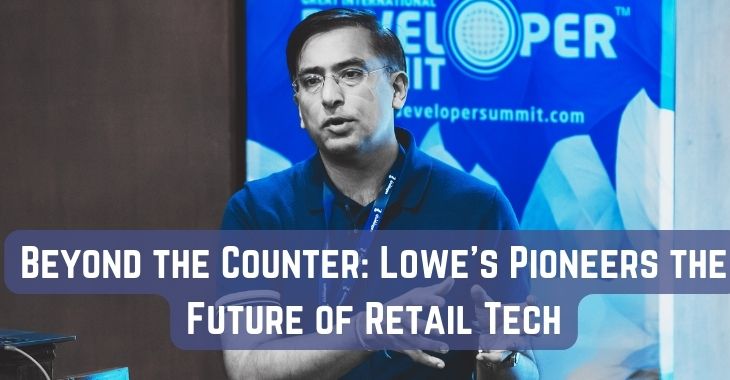
“Once again Saltmarch has knocked it out of the park with interesting speakers, engaging content and challenging ideas. No jetlag fog at all, which counts for how interesting the whole thing was."
Cybersecurity Lead, PwC

If you thought retail was static, think again. In a firecracker of a talk at Great International Developer Summit, Manasvi Sharma, the strategic mind behind omnichannel platforms at Fortune 50 behemoth Lowe's Companies Inc., unpacked the next big wave crashing onto the retail industry: headless commerce. Clocking in with over $90 billion in revenue, Lowe's isn't just a spectator in the changing retail game; they're shaping the field. But hold onto your hats, because this isn't just a blip on the radar. According to a GlobeNewswire report, the headless commerce market is expected to reach billions by 2031. And if that doesn't make you sit up and take notice, Appnova tells us that the current market size of $751.6 million is projected to balloon to a staggering $5,528.5 million by 2032. So, when we say Lowe's is shaping the field, we mean they're carving out a future in a market that's not just growing—it's exploding.
“Technology should not just be an enabler but a driver for business. As consumer preferences change, technology needs to keep pace,” Manasvi Sharma, Vice President - Omni Channel Platforms, Lowe's India
So, what's cooking in Sharma's kitchen of innovation? He kicked things off by emphasizing that technology has graduated from a sidekick to a central protagonist in the business narrative. In layman's terms, tech isn't just helping retail along—it's steering the ship. Single-channel is a bygone, multi-channel is yesterday's news, and omnichannel? That's where the action is. But don't just take Sharma's word for it. According to a Think With Google report, the average online customer journey now involves anywhere from 20 to 500 touchpoints. That's right, the customer journey has evolved into a complex web of interactions, making omnichannel not just a buzzword but the new standard for retail success.
“Customers today interact with brands through an average of six touchpoints. They are demanding seamless experiences that traditional retail architectures are not equipped to provide.”
But here's the kicker: customers aren't playing by the old rulebook. Sharma let it drop that the average consumer today rubs elbows with brands through six different touchpoints—skyrocketing from a mere two back in 2001. We're not just talking scrolling through websites and walking into stores; billboards, airplane screens, gym displays, and social media are all part of the mix. As for the retail tech powering these interactions? It’s lagging, desperately trying to catch up with this new consumer landscape. And if you think Sharma is just sounding the alarm, think again. According to a McKinsey report, retailers are facing an urgent need to transform their tech architecture to adapt to changing consumer behaviors. Magdalena Joczak, Vice President Strategy and Transformation at UPC Polska, also points out that one of the key challenges is maintaining a single customer view across multiple touchpoints. So, when Sharma says the tech is lagging, he's spotlighting a retail industry that's grappling with the complexities of a multi-touchpoint consumer world.
Enter headless commerce—a term you'll want to start dropping at dinner parties if you want to sound savvy. In this system, the customer-facing facade and the nitty-gritty back-end logic exist as separate entities. The brilliance, Sharma contends, is that this isn't just about divvying up responsibilities within a business—it reframes the whole game, turning our focus to the ecosystem at large. But the genius doesn't stop there. Industry insiders are buzzing about how headless commerce is revolutionizing retail by offering unparalleled customization. Imagine a world where your online shopping experience is as unique as your fingerprint, all thanks to the agility and flexibility that headless commerce brings to the table. So, headless commerce isn't just a buzzword; it's a seismic shift that's redefining the very architecture of retail.
Sharma didn't stop at just redefining terms. He introduced us to something even bigger: the age of "Living Services." Imagine your refrigerator notifying you when you're out of milk, or better yet, ordering it for you. These living services make products and services dynamically adapt to user needs and are the kind of change Sharma believes could benefit from headless commerce architecture. But let's dig deeper. According to an Accenture report, Living Services are poised to be the next big thing in retail, transforming how we interact with brands. Picture this: you walk into a store, and the environment itself adapts to your preferences, from the lighting to the music, all because of Living Services. So, we're not just talking about smart fridges; we're talking about an entire retail environment that evolves in real-time to meet individual needs.
He then turned to a more technical direction. He cited some intriguing case studies, like Shopify's success with API-first architecture. Shopify, he noted, has empowered over a million businesses by facilitating easy customization and scalability. It's evidence that adopting an API-first strategy, much like what headless commerce recommends, is more than just an industry trend—it's a proven recipe for success. But let's not gloss over the magnitude of this. According to industry discussions, like one from The API Economy, Shopify's API-first approach has been a cornerstone in leveraging other tech companies to build non-core components, thereby creating a more robust and versatile platform. This isn't just tech jargon; it's a transformative approach that's enabling even small retailers to offer customer experiences that rival those of retail giants.
“It's not just about separating layers within an enterprise but thinking about the entire ecosystem. We need to move towards composable business capabilities that can be integrated into hybrid applications.”
The Lowe's exec then threw down another card: "composable business capabilities." These aren't just techie buzzwords; they’re the building blocks that can be digitally or physically plugged into the business model. The magic lies in the plug-and-play interfaces like APIs and event pathways. With these, businesses can move as quickly as a meme goes viral, swiftly tailoring services or delivery methods to what the audience wants today, or even this minute. But let's unpack this a bit more. According to a Gartner report, composable business is about creating an organization from interchangeable building blocks. This modular setup not only allows for rapid adaptability but also fosters digital agility and resilience, especially crucial in the fast-changing retail landscape. So, when Sharma talks about composable business capabilities, he's essentially laying out a blueprint for retail's agile future.
With the discussion moving forward, Sharma ventured into the role of AI and machine learning in crafting personalized customer experiences. Through the use of data analytics and algorithms, AI can understand consumer behavior far better than traditional methods. This is particularly critical as personalization becomes the foundation for customer engagement in retail. But let's delve deeper into why this is so groundbreaking. We're talking about AI not just recommending products but also guiding customers through the entire shopping process, from finding a location to sending appointment reminders. This isn't just Sharma's vision; it's a transformative approach that's already gaining traction. In fact, insights from Harvard Business Review confirm that AI can design end-to-end solutions that not only understand consumer behavior but also transform the entire customer journey. This goes beyond mere product recommendations; it's about creating a seamless, personalized experience that can include everything from guiding you to the nearest store location to sending you appointment reminders.
“While the vision of a fully integrated, headless commerce ecosystem is compelling, it comes with its own set of challenges. Security and the handling of personally identifiable data are significant concerns.”
Of course, even the most compelling visions aren't without their snags. Sharma didn’t skirt around the elephants in the room: data security and personal privacy. When you're sharing data across a sprawling ecosystem, you'd better have your security ducks in a row. And it doesn’t end there. For this Utopian customer journey to take form, the industry needs to rally around a new set of guidelines, a new lingua franca of sorts. Securing customer data is a significant roadblock, especially when relying on third-party services in a headless commerce setup. This isn't just a minor hiccup; it's a critical issue that could lead to customer data leaks, as highlighted by a Cyntexa report. The industry must urgently address this to ensure that the sprawling ecosystem doesn't become a playground for data breaches.
As Sharma's talk wrapped up, he didn't miss the opportunity to address sustainability—an issue that's been in the spotlight for both consumers and corporations. He stressed that headless commerce isn't just about consumer satisfaction; it's a framework that can also be leveraged for sustainable retail practices by optimizing supply chains and reducing waste. Headless commerce's flexible structure allows organizations to quickly adapt to trends, including those in sustainability, as highlighted by Sitecore. This means that businesses can more easily implement eco-friendly practices, such as carbon labeling and clearly sign-posted delivery options, which are considered best practices in sustainable commerce according to Bloomreach. So, headless commerce isn't just a tech innovation; it's a pathway to a more sustainable future in retail.
So, what are we to make of Manasvi Sharma's crystal ball into retail's tech-driven destiny? Simply put, it's a call to arms. In a landscape where customers demand immediacy, smooth transitions, and versatility, it's the retailers who master the high-tech symphony of headless commerce and composable business capabilities that will lead the parade. And if Sharma and Lowe’s have their way, they won’t just be part of the parade—they’ll be directing it.
Watch the full video of the talk, here.
Have questions or comments about this article? Reach out to us here.
Banner Image Credits: Manasvi Sharma at Great International Developer Summit

“Once again Saltmarch has knocked it out of the park with interesting speakers, engaging content and challenging ideas. No jetlag fog at all, which counts for how interesting the whole thing was."
Cybersecurity Lead, PwC

“Very much looking forward to next year. I will be keeping my eye out for the date so I can make sure I lock it in my calendar."
Software Engineering Specialist, Intuit

“Best conference I have ever been to with lots of insights and information on next generation technologies and those that are the need of the hour."
Software Architect, GroupOn

“Happy to meet everyone who came from near and far. Glad to know you've discovered some great lessons here, and glad you joined us for all the discoveries great and small."
Web Architect & Principal Engineer, Scott Davis

“Wonderful set of conferences, well organized, fantastic speakers, and an amazingly interactive set of audience. Thanks for having me at the events!"
Founder of Agile Developer Inc., Dr. Venkat Subramaniam

“What a buzz! The events have been instrumental in bringing the whole software community together. There has been something for everyone from developers to architects to business to vendors. Thanks everyone!"
Voltaire Yap, Global Events Manager, Oracle Corp.